There’s nothing more satisfying for a keen hobbyist like me than seeing my fish thriving and happy through crystal clear glass. I never thought I’d be able to do that without hard-to-remove algae or limescale stains ruining my view. Then I discovered a tank cleaning miracle product!
In this guide, I’ll share with you how I keep my tank so clean. And it’s not down to rocket science or pricey chemicals! My pristine tank is down to good old-fashioned vinegar. That’s distilled white vinegar to be precise.
Cleaning your fish tank with vinegar is a cheap and extremely effective way to shift stubborn hard algae and water stains from your tank glass, ornaments, and even plants.
Green Spot Algae
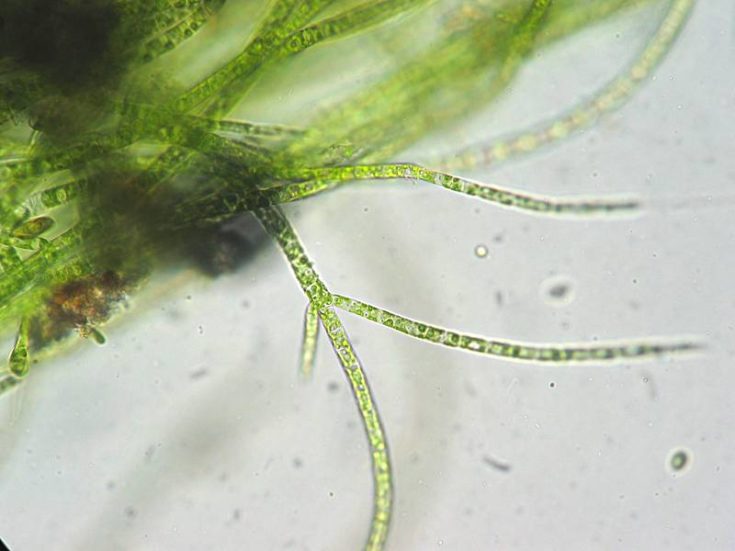
Most forms of algae are soft and easy to remove, simply by gently rubbing them with a sponge. However, Green Spot Algae is much harder to shift, as it forms rock-hard spots that stick like superglue to your tank glass, decorations, and even plants.
Hard Water Stains
Hard water stains are caused by minerals (calcium) in the water. As the water evaporates, the minerals are left behind, leaving a white residue on the glass. Those same mineral deposits can also coat filter equipment that’s not submerged. Vinegar can shift those stains quickly and easily!
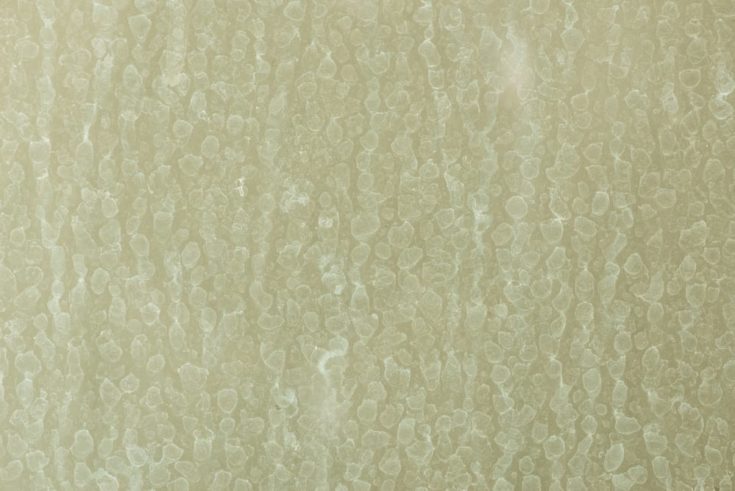
And that’s not all!
Using the correct white vinegar to water ratio for cleaning your aquarium means that you can also use it to disinfect your filtration system without harming beneficial bacteria or your fish. Even better, where other methods of tank cleaning don’t last or leave behind residual blemishes, vinegar is strong enough to shift the toughest stains safely and without the risk of damage.
So, if you want a cheap, safe, effective solution to your aquarium cleaning blues, read on!
What You’ll Need
Before you begin, you’ll need to assemble the following kit:
- White vinegar
- 2 clean sponges
- Table salt
- Razor Blade scraper or an old razor
- Tap water
- Hosepipe
- Old toothbrush
- Magnetic algae cleaner
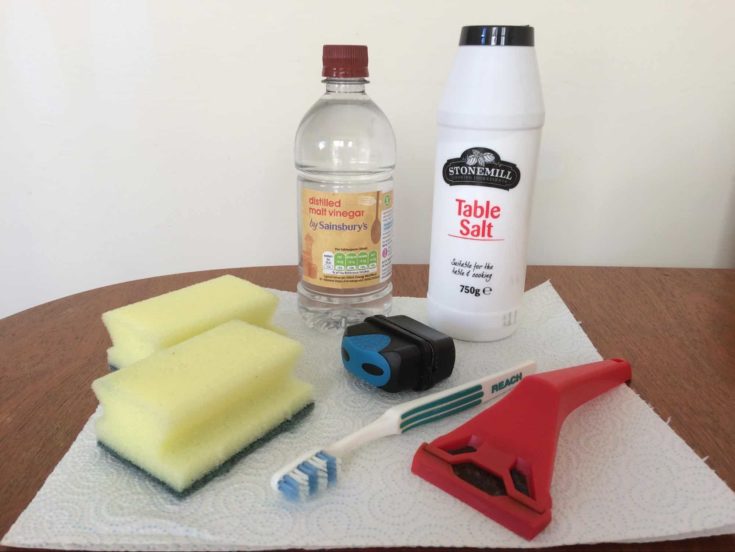
You can find everything that you need for this job in your local grocery store or online at the links we’ve provided.
How To Do It
Here’s how to clean your fish tank using vinegar. You can use the same basic method that’s described below to clean your tank with the fish still in it or to clean and disinfect an empty.
I always use vinegar to clean new ornaments and plants before adding them to my fish tanks. That way, I know that any potential bacteria or parasites will be removed and my fish will be safe.
Stage 1 – Deep-Clean Your Tank
You can use this method on glass and acrylic tanks. However, be very gentle when scrubbing away tough stains on plastic or acrylic aquariums so that you don’t scratch the surfaces.
1. Empty The Tank
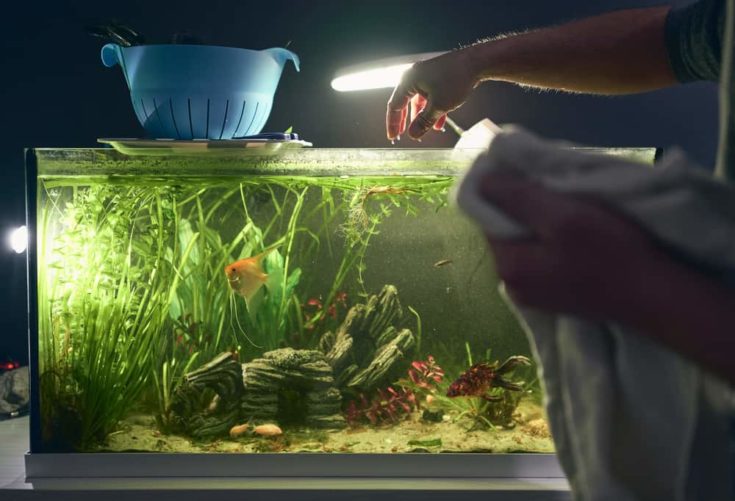
Start by emptying your fish tank. Transfer the fish to a separate tank, remove plants and decorations, and then empty the aquarium completely.
2. Loosen The Stains With Water
Moisten a sponge with tap water and use it to wipe down the inside and outside of the tank. The idea is to loosen and remove some of the algae and loosen the calcium deposits. Use the sponge gently so that you don’t scratch the surface, especially if your tank is acrylic.
3. Apply Table Salt
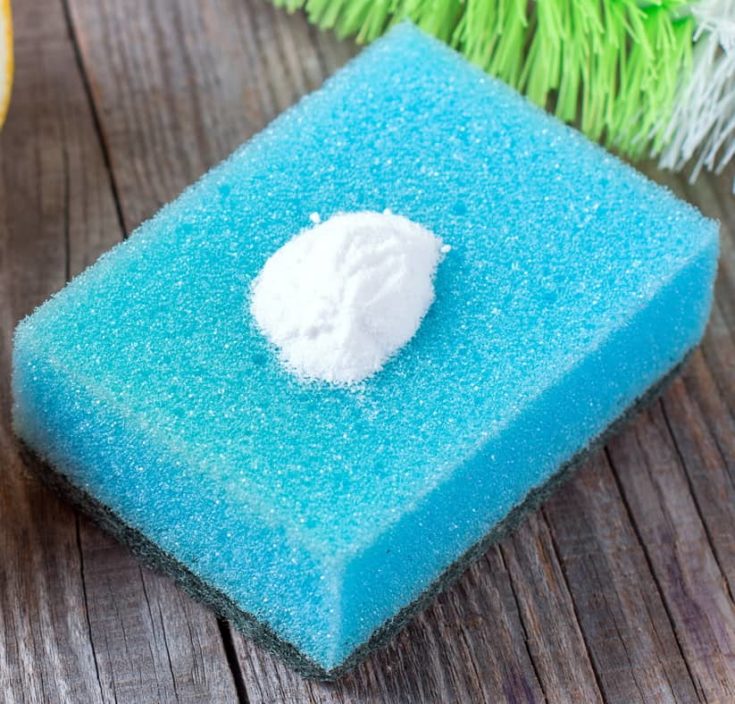
Take the same sponge, moisten it, and add some table salt to the sponge. Wipe down the whole fish tank again. Gently scrub the tank, concentrating on stubborn stains.
Leave the salt in sit for a few minutes but don’t allow it to dry completely.
4. Rinse The Tank
For this step, it’s useful if you can place the tank in a bathtub or outside on the grass, close to a tap.
Connect your hose to the faucet, and rinse out the tank thoroughly.
5. Scrape Off Stubborn Stains
Skip this step if you have an acrylic or plastic tank.
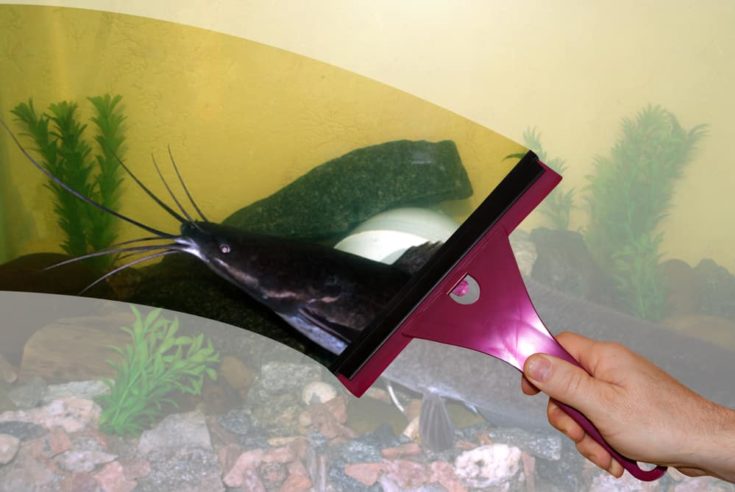
Use a razor blade to very gently scrape away hard algae and calcium deposits from the glass.
6. Clean The Tank With Vinegar
Make up a solution of 1 part tap water to 1 part vinegar. Pour the solution onto a clean sponge, and use it to scrub the whole tank until the remaining algae and calcium stains are gone.
Don’t forget to clean the glass on the outside too.
7. Rinse The Tank Thoroughly
Finally, rinse the tank thoroughly with clean tap water. Allow the tank to dry completely.
Stage 2 – Clean Decorations, Plants, and Peripherals
Now, move on to cleaning your plants, decorations, and filtration equipment if necessary. When you’ve finished, be sure to rinse everything thoroughly in clean tap water before you replace the items in the aquarium.
1. Clean Your Plants
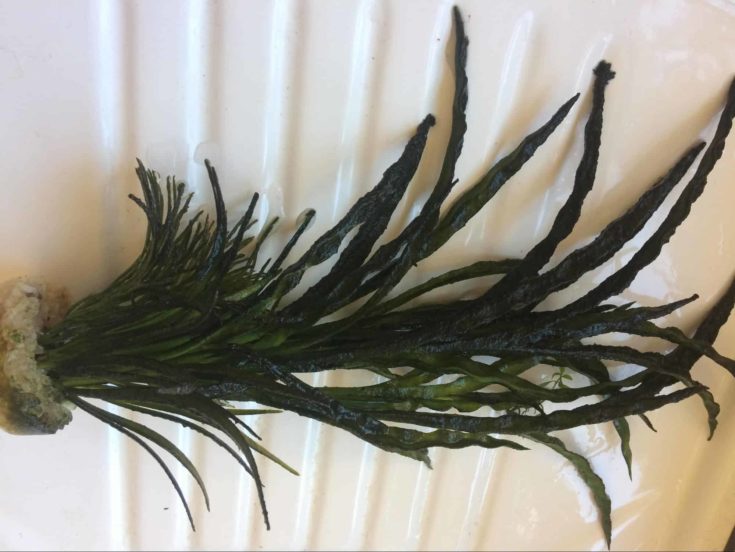
To remove heavy algae concentrations from living plants, make up a solution of white vinegar and water in the ratio of 1 part tap water to 1 part vinegar.
Allow the plants to soak in the solution for no more than five minutes.
2. Rinse The Plants
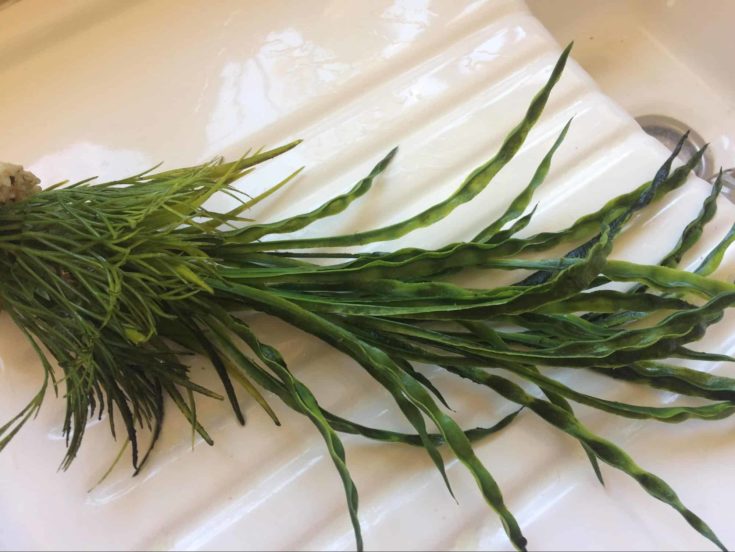
Carefully rinse the plants under cool running water to remove the loosened algae and vinegar solution. Replace the plants in your tank.
3. Soak Tank Decorations
To clean resin ornaments, pebbles, and rocks, place them in a bucket containing a solution of water and vinegar in the ratio of 1 part tap water to 1 part vinegar.
Leave the decoration to soak in the solution for at least 10 minutes.
4. Scrub Away Stubborn Stains
Rinse the decorations under clean, running water.
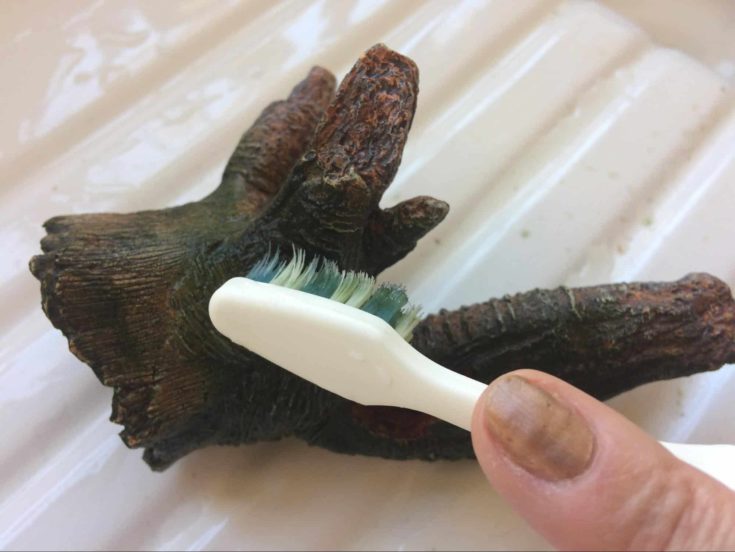
Finally, use an old toothbrush to scrub the items to get rid of any stubborn stains. At this stage, you may need to dip the toothbrush in undiluted vinegar and focus on any areas of really bad staining.
5. Clean Filters, Aquarium Covers, Etc.
Use a solution of water and vinegar in the ratio of 1 part tap water to 1 part vinegar and your sponge to gently scrub away hard water staining from all items of aquarium peripherals, including filter casings, covers, etc.
To clean and disinfect your filter unit, remove the filter medium, and place it into a small bowl of tank water. Take the unit apart, and soak the pieces in a solution of water and vinegar in the ratio of 1 part tap water to 1 part vinegar for 10 minutes.
Rinse all the pieces of the filter unit thoroughly in clean, running water. Reconstruct the unit, and replace the filter media.
Cleaning Your Aquarium Without Removing Your Fish
You can use distilled white vinegar to remove Green Spot algae from your tank glass without disturbing your fish or taking down your setup altogether.
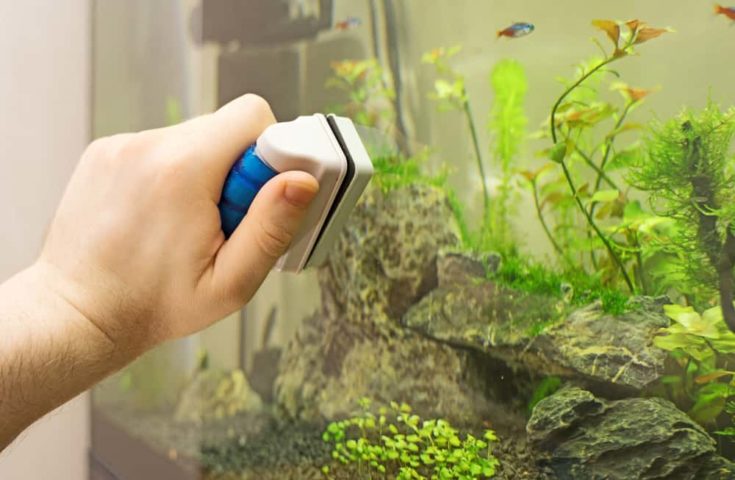
Simply take an aquarium magnet cleaner and pour some vinegar onto the scrubbing side of the cleaner.
Now, gently scrub the algae patches with the magnet cleaner until the green spots come away.
Conclusion
I hope you enjoyed my tutorial!
Keeping my aquarium free from hard water and algae stains keep the tank looking good and can reduce the damage to your filtration system that calcium deposits may cause if they are allowed to accumulate.
Please tell me how you got on with cleaning your aquarium using white vinegar, and don’t forget to share the article if you found it helpful.
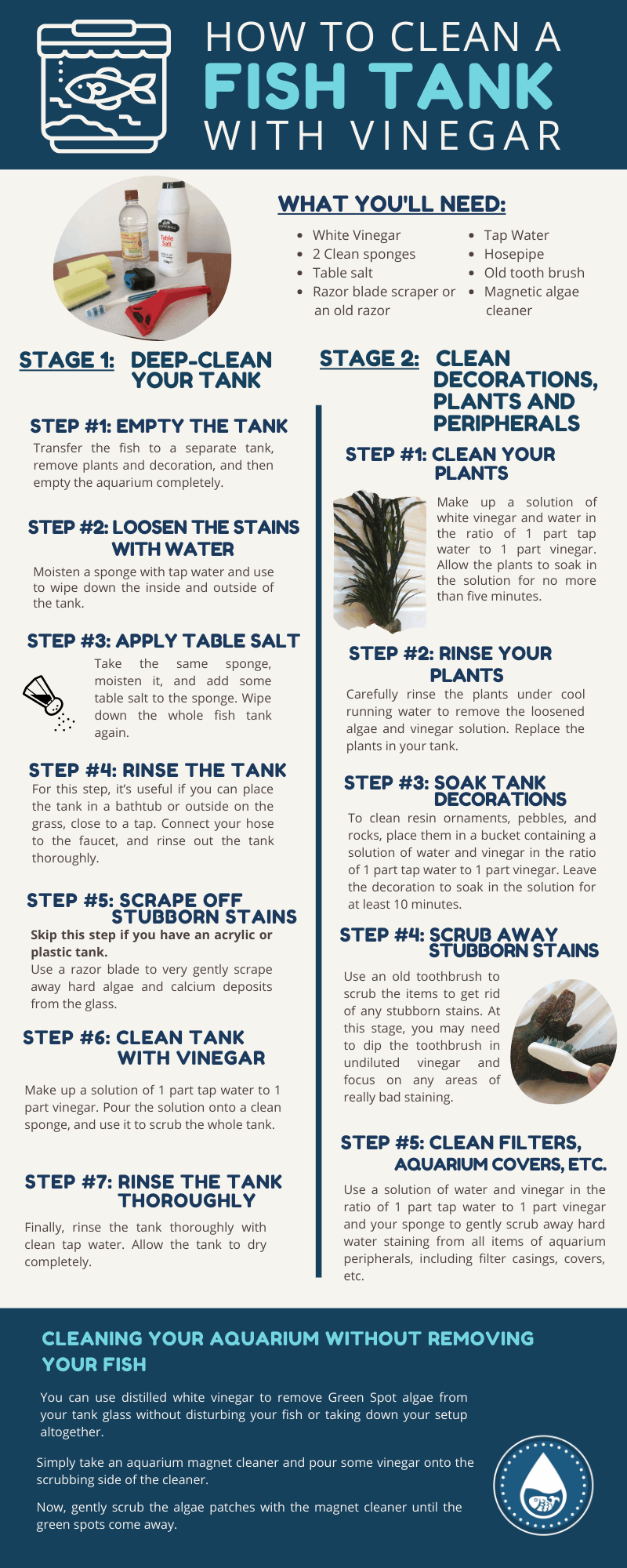

Love it natural and gentle
Thank you for your great advice. Especially washing ornaments and plants in vinegar when new.
Thank you for your great advice, I did exactly what was instructed and my tank has never looked better.
I had trouble with Black beard algae and now it has gone completely!
Thanks again.
Elaine
Thanks for all your advice . . . I really didn’t have a clue!
Was a great read & well explained for newbys to the underwater world. I’ve been using wht Vinegar for over 10yrs bcos it’s a pH neutraliser. You can’t beat it & even be able to clean up your sponges&brushes in it.
Thank you! I have been using white vinegar for years to get rid of calcium deposits but did not know it was useful for algae, too! And I was surprised to learn about cleaning the tank with the fish in the tank.
Tom
Steps to Clean Old Aquarium Gravel: Step one is the standard cleaning solution: about 10% bleach and 90% hot or warm water, or you can use a lower concentration of bleach to be safe for fish after that. The second step is to put the fish gravel in the pot plus the bleach solution, pour the water to cover the gravel. Soak the gravel for no more than a quarter of an hour, during which time you can stir to irritate the cleaning solution. The fourth step is to rinse the aquarium gravel and then dry it. Finally, return it to the aquarium.
For me, this method is easy, convenient, and requires only common home materials.
Need help how to measure 1 part of water and 1 part of vinegar what does it mean I didn’t understand
It means equal parts so one cup of water mixed with one cup of water( equal parts) or 1/2 gallon vinegar mixed with 1/2 gallon water… in other words 50/50 ratio.
Thank you very much I bought a used tank and it was very dirty the vinegar work great made my tank look new thanks again for the help
Does the vinegar method remove odor?
For example, if you use 2 cups vinegar you would use 2 cups of water or if you use a quart of vinegar, you would use a quart of water.